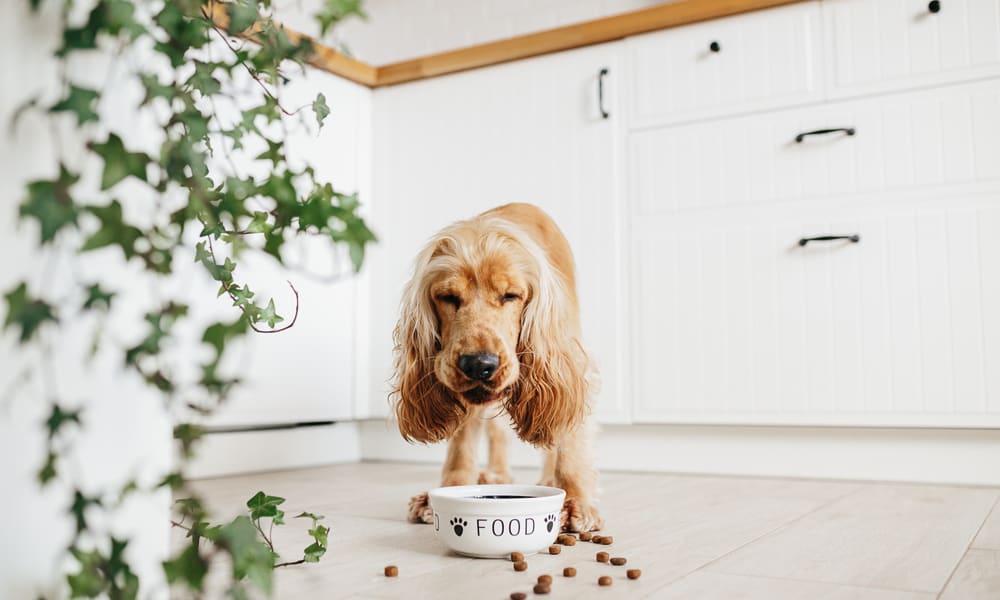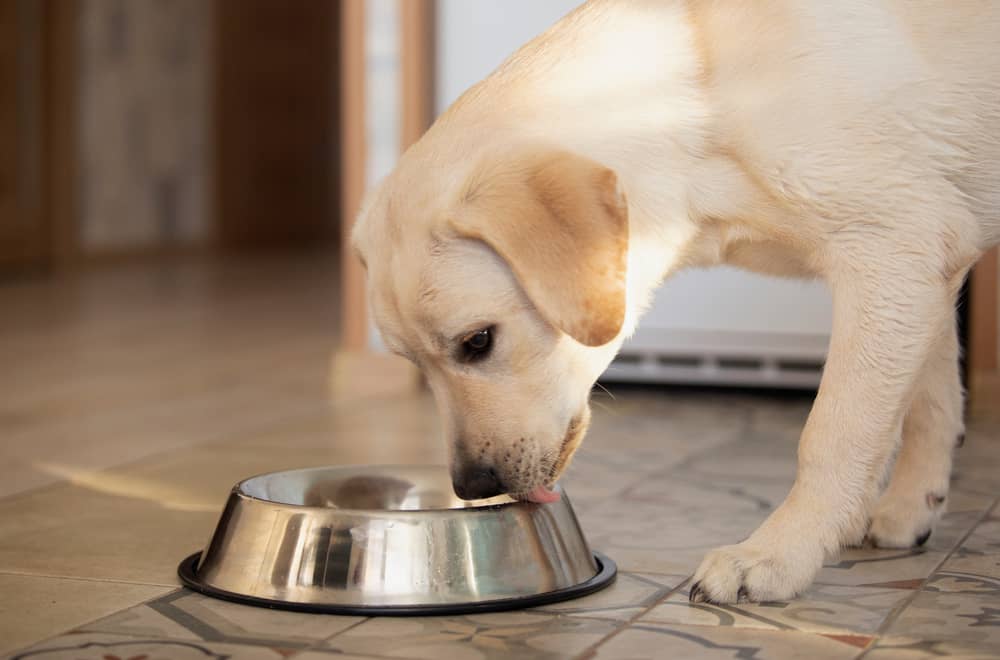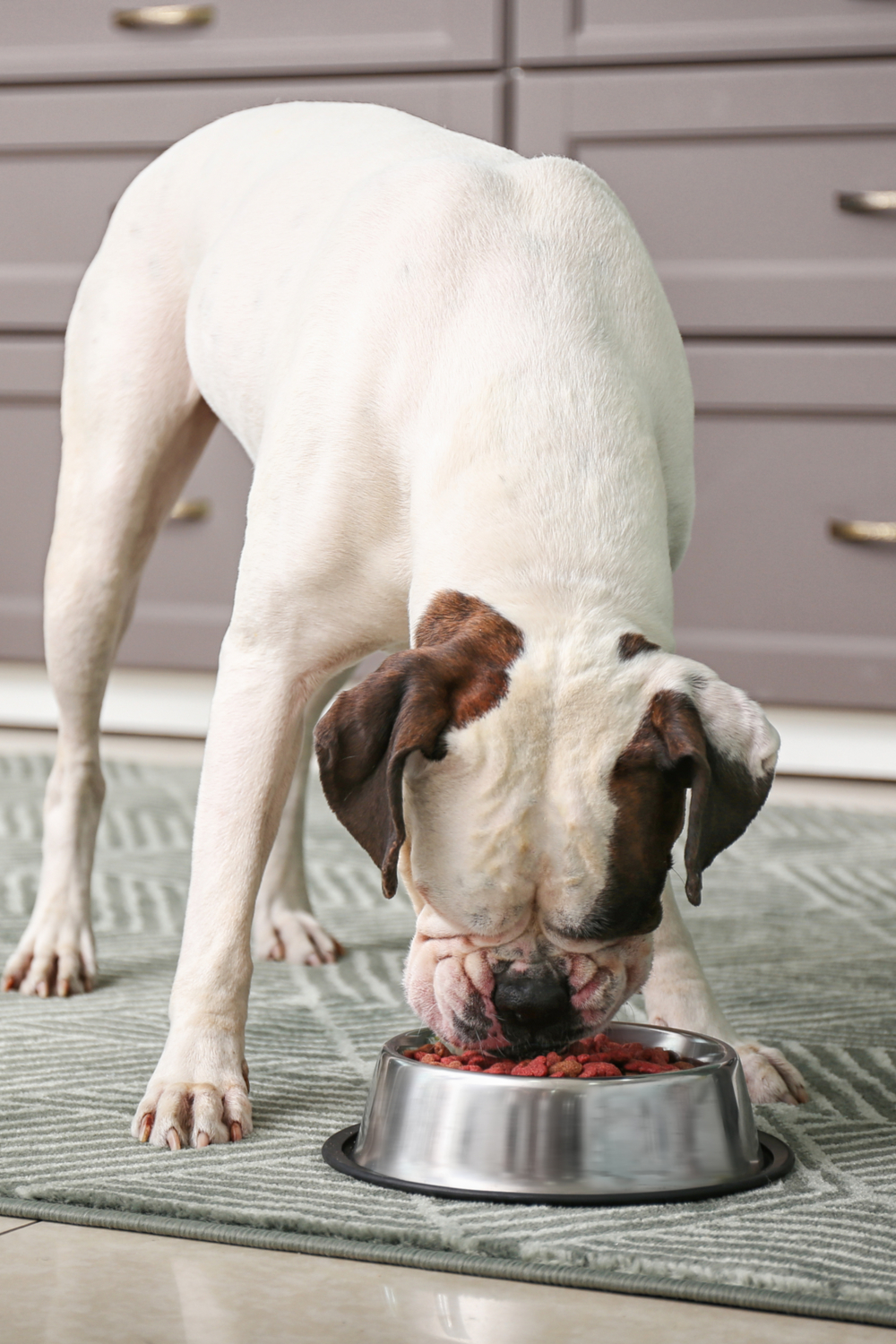Does your canine friend seemingly swallow food whole without taking even a few seconds to chew? Does he always behave like he has been starving for days when you serve his favorite kibble? You might be wondering, ‘why does my dog eat so fast?’
Some dogs will take their time with food. Others will want to wipe out their bowl in the shortest time possible. From an innate spirit of competition, intestinal parasites, to disease, there are several reasons for a dog eating so fast.
In this article, I will explain everything you need to know about why dogs eat so fast. We will talk about
- 4 reasons why dogs eat so fast
- Dangers of your dog eating too fast
- How to get your dog to eat more slowly
So, let’s get straight to it!
4 Reasons Why Dogs Eat So Fast
A dog can eat fast out of habit, if it is feeling threatened by other animals, or suffering from a parasitic infection or chronic disease. Fido might also start eating hungrily if he isn’t getting enough nutrients from his usual kibble.
Let’s take a look at each of these reasons.
1. A dog may eat fast out of habit
Dogs have evolved over thousands of years from wild wolves to the sweet domestic companions they are today. Still, they have some of their ancestors’ tendencies, such as wolfing down food.
Like their wolf ancestors, dogs are competitive in nature. This behavior is usually brought to full display were a limited resource, such as food, is concerned.
Your pup may wolf down food out of pure instinct. In the wild, animals eat their prey as quickly as possible; otherwise, other fellow animals might grab the prey, and an animal can easily go hungry until the next hunt.
For their own survival, wild animals habitually swallow their food fast. This survival instinct is the reason your canine buddy eats fast.
Interestingly, a dog can eat fast even when it is the only animal in the house. You would think that being an ‘only child,’ Fido wouldn’t feel threatened and would take the time to enjoy his food.
If your dog has a competitive streak, it might carry on this behavior to mealtime. Not all dogs are competitive, and some with a subdued personality might be slow eaters.
You do not have to be too concerned about a competitive dog. As long as Fido doesn’t have any health problems, you can let him be as competitive as he wants.
2. The dog is feeling threatened by other animals
Do you have other dogs in the house? Or maybe you have several cats? Some dogs, especially those of smaller stature, may feel the need to eat quickly lest other animals finish the food.
This behavior is inbuilt in some dogs and is inherited from their wild ancestors. Even if each pup has its own bowl and enough food to go around, some dogs don’t feel safe eating leisurely in the presence of their ‘competitors.’
If your dog seems threatened by others, try feeding him in a separate room or somewhere away from the rest of the animals if possible.
The less vulnerable the dog feels around food, the less it might feel the need to wolf down. Fido may eventually take to eating more slowly.
3. The dog has an intestinal parasite infection
Intestinal parasites such as roundworms, ringworms, hookworms, heartworms, and others are fairly common in dogs.
Your pup may pick up worms from feces, soil, food, contaminated water, and from licking its own fur. Once ingested, the larvae attach themselves to the intestine walls, where they grow into adults worms.
A worm infestation will cause appetite changes in your dog. Fido may lose his appetite or eat very little, or you might notice a sudden increase in appetite accompanied by wolfing down of food.
Despite wiping out his bowl hungrily, your pup might still lose weight day by day due to the parasitic infection.
You might notice Fido eating fast or hungrily because he is actually hungry. The parasites, logged in the intestines, feed on every little food your dog eats. The result is your dog feels hungry almost all the time despite giving him enough food.
If you notice symptoms of a parasitic infection, bring your dog to the veterinarian for appropriate treatment.
4. The dog might be suffering from a chronic disease
Aside from a parasitic infection, another reason your dog is eating too fast could be that he is suffering from a disease such as diabetes mellitus, Cushing’s disease, or any other ailment that could cause an artificial appetite increase.
Check if your dog is suddenly eating fast, and the behavior is accompanied by excessive panting, increased thirst, increased urination, reduced activity, and an enlarged abdomen. The chances are good that the dog has an underlying health issue.
Diseases such as Cushing’s and diabetes are very serious, and you should seek medical advice from your veterinarian. Your dog’s life expectancy can shorten fast if you do not take immediate action to treat Fido.
Is It Safe For A Dog To Eat So Fast?
A dog eating too fast can present several dangers. For one, when your pup swallows food without chewing it enough, there is a very high risk of choking. Unfortunately, many people have lost their canine buddies from choking on food.
Another hazard of a dog eating too fast is the risk of gastric dilatation-volvulus or “GDV.” This painful and potentially life-threatening disease happens when the stomach expands excessively and twists in the abdomen.
When a dog eats too fast, it takes in a lot of air, which causes the stomach to expand and painfully twist, sending the dog into shock fast. If left untreated, GDV can quickly turn fatal.
Eating too fast can also result in less serious but equally uncomfortable symptoms such as vomiting and gagging.
When your pup habitually eats too fast, he might miss out on getting enough nutrients needed for strength and development. Chewing food allows for easy digestion and assimilation, enabling the body to absorb as many nutrients as possible.
Fortunately, there are a few tricks to slow down your chomper and encourage him to eat more slowly. Let’s take a look at that next.
How To Get Your Dog To Eat More Slowly
You can get your dog to eat more slowly by:
- Availing a slow feeder
- Using a puzzle feeder
- Placing food in a portioned plate or pan
Let us take a look at how each method works.
Availing a slow feeder
Slow feeders are pet bowls with nooks, crannies, and obstacles that force your dog to pick up small quantities of food at a go.
The nozzle can reach every corner of the bowl, so Fido will not have a problem picking up food with his tongue.
Smaller quantities of food are easy to digest and absorb in the body, ensuring your dog gets enough nutrients.
The only downside is you might have to try different feeders to find one that works the best for your dog. Some dogs will take up the first slow feeder you introduce. Others might be a bit picky and require more variety before they choose one they love.
Using a puzzle feeder
A puzzle feeder kind of works like a slow feeder and serves the same function. But puzzle feeders can make mealtimes a bit more fun.
Food puzzles are both toys and feeding plates. They feature small compartments where you can place the food and allow your dog to explore each compartment.
Some toy puzzle feeders will release food in small amounts when Fido hits, shakes, or rattles the toy.
Puzzle feeders might be a bit messier than you are used to. But these toys can prevent choking hazards, and their benefits outweigh their downsides.
Placing food in a partitioned plate or pan
If you have one of those partitioned plates, you can convert it into a food bowl to get your dog to eat slower. Place small portions of food in each partition and let Fido take his time enjoying his kibble.
Partitioned plates are not only an affordable solution, especially if you have more than one dog; these plates also offer easy but controlled access to the food so Fido will not become frustrated and stop eating altogether.
Summary: Why Does My Dog Eat So Fast?
Some dogs eat so fast, mostly out of habit and as a survival instinct. If your pup has always been a fast eater, there is little to worry about.
But, you should consider solutions such as slow feeders to get Fido to eat more slowly to avoid gagging, vomiting, gastric dilatation-volvulus, or worse, choking.
There might be a health problem if your canine buddy suddenly eats too fast and presents other strange symptoms. Watch out for signs such as increased thirst, lethargy, and a swollen stomach, and visit your veterinarian for diagnosis and treatment.


